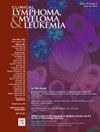在加拿大阿尔伯塔,先前暴露于蛋白酶体抑制剂和免疫调节剂联合治疗的多发性骨髓瘤患者的临床结果
IF 2.7
4区 医学
Q2 HEMATOLOGY
引用次数: 0
摘要
背景:蛋白酶体抑制剂(PI)和免疫调节药物(IMiDs)是多发性骨髓瘤(MM)患者早期治疗的重要支柱。本研究考察了双级暴露(DCE) MM患者在先前PI和基于imid的治疗后的现实世界治疗模式、临床结果和医疗资源利用率(HCRU)。方法:使用加拿大阿尔伯塔省的综合管理数据库对DCE患者进行识别。在2012年1月至2022年12月期间开始后续治疗(LOT)的DCE患者被纳入研究。结果:在研究期间确定的831例DCE患者中,有后续LOT,中位年龄为68.0岁。IMiD(61%)是双级暴露后最常用的治疗类别,其次是PI(39%)和单克隆抗体(26%)。第一次LOT后的流失率(定义为在接受下一次LOT前死亡)为27%,第二次至第三次LOT后的流失率为30%。到下一次治疗或死亡的中位时间为12.1个月(95%可信区间:10.3-14.1),从双级暴露后下一次LOT开始的中位总生存期为34.4个月(30.3-40.2)。在LOT开始后的第一年,医疗资源利用率(HCRU)很高,平均有1次急诊科就诊,1次住院,30次门诊就诊,3次输液预约,56次独特的医疗保健就诊。患者平均花费42.2天进行实验室检查。结论:接受双级暴露治疗的MM患者的临床结果仍然不是最理想的,有很高的损耗率和大量的医疗保健使用,强调需要减轻患者负担的治疗。本文章由计算机程序翻译,如有差异,请以英文原文为准。
Clinical Outcomes for Multiple Myeloma Patients With Prior Exposure to a Combination of a Proteasome Inhibitor and an Immunomodulatory Agent in Alberta, Canada
Background
Proteasome inhibitors (PI) and immunomodulatory drugs (IMiDs) are important backbones in early line treatments for patients with multiple myeloma (MM). This study examined real-world treatment patterns, clinical outcomes and healthcare resource utilization (HCRU) of double-class exposed (DCE) patients with MM after prior PI and IMiD-based treatment.
Methods
DCE patients were identified using integrated administrative databases in the province of Alberta, Canada. DCE patients who commenced subsequent lines of therapy (LOT) between January 2012 and December 2022 were included.
Results
Among 831 DCE patients identified to have initiated subsequent LOT during the study period, median age was 68.0 years. IMiD (61%) was the most commonly used therapeutic class after progressing on double-class exposure, followed by PI (39%) and monoclonal antibodies (26%). Attrition rates after first subsequent LOT, defined as death before receiving the next LOT, was 27%, and attrition from second to third subsequent LOT was 30%. Median time to next treatment or death was 12.1 months (95% confidence interval: 10.3-14.1) and median overall survival was 34.4 months (30.3-40.2) from the start of the next subsequent LOT after double-class exposure. healthcare resource utilization (HCRU) during the first year of starting subsequent LOT was high, with a median of 1 ED visit, 1 inpatient admission, 30 clinic visits, 3 infusion appointments, 56 unique healthcare encounters. On average, patients spent 42.2 days on laboratory tests.
Conclusion
Clinical outcomes among patients with MM initiating postdouble-class exposure treatments remain suboptimal, with high attrition rates and significant healthcare use, highlighting the need for therapies that reduce patient burden.
求助全文
通过发布文献求助,成功后即可免费获取论文全文。
去求助
来源期刊

Clinical Lymphoma, Myeloma & Leukemia
ONCOLOGY-HEMATOLOGY
CiteScore
2.70
自引率
3.70%
发文量
1606
审稿时长
26 days
期刊介绍:
Clinical Lymphoma, Myeloma & Leukemia is a peer-reviewed monthly journal that publishes original articles describing various aspects of clinical and translational research of lymphoma, myeloma and leukemia. Clinical Lymphoma, Myeloma & Leukemia is devoted to articles on detection, diagnosis, prevention, and treatment of lymphoma, myeloma, leukemia and related disorders including macroglobulinemia, amyloidosis, and plasma-cell dyscrasias. The main emphasis is on recent scientific developments in all areas related to lymphoma, myeloma and leukemia. Specific areas of interest include clinical research and mechanistic approaches; drug sensitivity and resistance; gene and antisense therapy; pathology, markers, and prognostic indicators; chemoprevention strategies; multimodality therapy; and integration of various approaches.
 求助内容:
求助内容: 应助结果提醒方式:
应助结果提醒方式:


